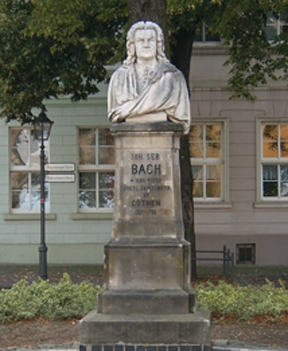 Here are some more fun facts about Bach, provided by chorister and writer extraordinaire Natasha Regehr.
Here are some more fun facts about Bach, provided by chorister and writer extraordinaire Natasha Regehr.
Bach the Jailbird
Well, things went sour with the old duke, who was in a tiff with the local prince. “My musicians won’t talk to your musicians any more,” the nobles pouted. Then Bach was passed over for a promotion in favour of the boss’s kid, and what did feisty J. S. do? He defected to the enemy prince, of course, and was promptly thrown in jail. Fortunately, he was quite capable of writing organ music in his head, so at least he got something done while he was there. After a month they let him go, and, at 32, he began a happy six-year stint working for a Calvinist prince who didn’t like church music. “No matter,” thought Bach. “I’ll write instrumental music instead. Lots of it. And the prince will jam with me, and we’ll travel all over the place for months at a time with our funky folding harpsichord.” Oh, yes, it sounds glamorous. But disaster loomed. When he was 35, Bach returned from a tour with his rock-star prince only to find his beloved cousin-bride dead and buried. It seems no one thought to text him that she was ill.
Bach Robs the Cradle
Being a resilient fellow on the rebound, Bach was not in mourning long. By age 36 he’d scored a new wife, a 20-year-old soprano named Anna Magdalena. She gladly bore him another 13 children, in between mothering her new step-children, keeping house, and copying out her hubby’s reams of sheet music. Handy to have a live-in nanny-slash-secretary, isn’t it, Johann? Well, they were reportedly very happy together for 28 years, and you needn’t worry too much about poor Anna having to look after 20 little ones. Sadly, only ten survived infancy, so Anna likely spent as much time grieving as she did nursing.
Blue-Collar Bach
Meanwhile, the rock-star Prince Charming was celebrating his own nuptials, and his dour new princess disapproved of her man’s musical frivolities. So off Bach went to seek his fortunes once again, toting his tribe of little Bachs with him. They moved to the big, cosmopolitan city of Leipzig, where the boys could go to college and their dad could spend the rest of his life laboring under unappreciative superiors in appalling working conditions for inadequate pay. Yes, gone were the days of traipsing around the country with the royal caravan. Poor Bach was now a lowly schoolteacher responsible for 54 unruly choir boys, of which he said that “17 are competent, 20 not yet fully, and 17 incapable.” He parcelled the worst of them off to the least important churches and kept the best to sing the 300-odd cantatas he wrote for the snazzier churches. Eventually a “progressive” new schoolmaster came in with the crazy idea that students should be learning more practical subjects than music, theology and Latin, and drastic cuts were made to the music program. Sound familiar? Mr. Holland would have to write his opus elsewhere.
Bach Goes Clubbing
Well, Mr. Bach kept his annoying day job, but his heart had gone downtown. At 44 he had his own little mid-life crisis, Baroque-style, and started doing weekly gigs at Zimmerman’s Coffee House and other trendy hotspots. He began writing music for town and college bands, where he was appreciated at last. As he aged, he cavorted with the likes of Frederick the Great, had many visitors to his six-clavier household, and composed the incomparable B Minor Mass.
Blind Old Bach
All of that moonlight music-copying finally caught up with old Bach, however, and his vision started to go. When he was 65, he had cataract surgery on both eyes, which turned out to be a very bad idea. He spent his last days in a darkened room dictating sacred compositions to his student-turned-son-in-law. Then, oddly, he woke up one day with the ability to see clearly in broad daylight, and promptly had a stroke and died.
Bach’s Bare Bones
J. S. Bach was buried in an unmarked grave that was somehow rediscovered in 1894, when his bones were exhumed and placed in a church sarcophagus that was bombed in World War II. Fortunately, someone thought to rescue old Bach’s bones, and buried them safely in 1949 in the alter-room of the church that had so underestimated the greatness of its cantor. And that’s where they are today, if in fact they’re actually his.
More important than the bones, though, is the staggering body of musical work that Bach left behind for his sons to either preserve or squander, as they saw fit. Fortunately, C. P. E. Bach had the good sense to look after his share of his old man’s scribblings, which set the course of Western music for centuries to come.
